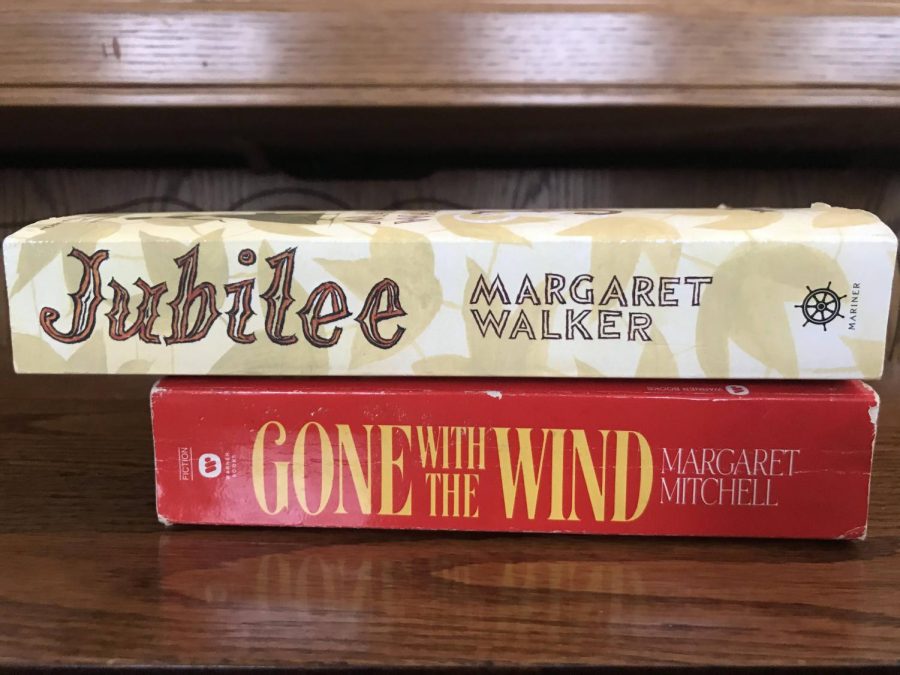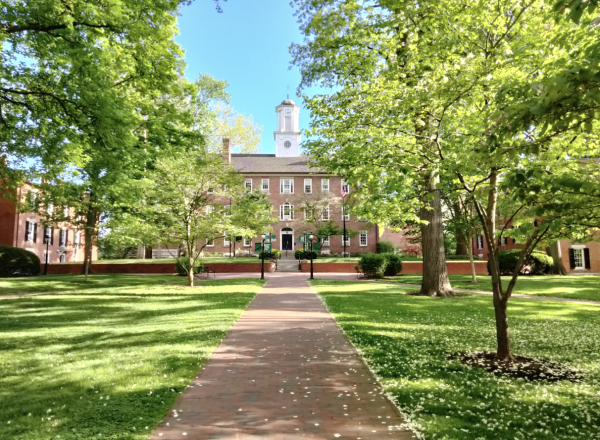In Place of “Gone with the Wind,” a New Book on the Old South
Margaret Walker’s 1966 novel Jubilee touches on the African American experience during the Civil War and Reconstruction in ways that Gone with the Wind does not.
As America faces a period of reckoning about our identity and the perspectives of cultural and racial groups that are fused to it, titles such as Gone with the Wind bear examining. Margaret Walker’s novel Jubilee is primed for this moment of re-examining since it voices a counter-dialogue to Gone with the Wind. Walker’s 1966 historical novel is not a deliberate parody on the popular work (other titles such as The Wind Done Gone have attempted to re-write the story from the perspective of the enslaved) but it gives a sweeping life to the struggles and suffering of African Americans during the antebellum, Civil War, and Reconstruction periods omitted in Gone with the Wind.
Today’s political correctness has begun to dismantle Gone with the Wind’s zenith, but it still reverberates in its cultural impact for earlier generations. Written in 1936 by Margaret Mitchell, the book was made into the masterfully complex motion picture three years later. I say “complex” because the filmmakers manage to craft an enchanting screenplay of the South’s antebellum era and bring alive the romance that ties the remaining three hours of Civil War ruin and Reconstruction together. Yet this aesthetic viewing experience is complicated by the film’s glaring racial politics. Following the Emancipation Proclamation, several of the enslaved persons remain with the O’Hara family, suggesting their continued dependence on the paternalistic system and playing on racial tropes of the “loyal slave.” Then there are the aspects of the book that the film itself has censored, including the decision of former landowning gentry to join the Ku Klux Klan, claiming that they are defending Southern womanhood, and the presence of racial slurs.
Quite obviously, Gone with the Wind has endured recent controversy, notably in June 2020 when the streaming service HBO Max decided to temporarily pull the film from its library, before reintroducing it with introductory historical context from African American film scholar Jacqueline Stewart. What is more difficult to entangle is the relationship between the work’s ideological impact and the genre it inhabits. Gone with the Wind (in both book and movie form) is a romance, telling the story of defiant Southern belle Scarlett O’Hara and her maturation as her way of life changes. However, for some it has become more than a romance and upheld the romantic image of Southern institutions, the Civil War as a “lost cause” and chronicle of Northern aggression, and the thesis that Reconstruction interrupted the progress of the South forever. Keep in mind that the novel came to birth during the troubled racial era of the 1930s. It stands as an ideological monument not to the history of Confederacy, but rather the Confederacy as it seeks to be remembered.
Among the opening swirl of balls, suitors, and plantation extravagance in the novel’s first of 1000 pages, we begin to sense that Scarlett will distinguish herself from the docile, submissive model of Southern womanhood. Despite Scarlett’s ability as a character to cast off this veneer and fight for herself, the novel seems ignorant of the larger veneer that the antebellum South uses to obscure its brutality and justify itself. As an English student, I can’t help but critique the text for its internal contradictions, analyzing it from a variety of different lenses – Marxist in the relationship between land and status, feminist in the learned helplessness of women, postcolonial in the patronizing portrayal of Black people and the omission of their voices. Perhaps the conditioning of Southern woman into physical weakness and moral elevation hints at the psychology of the Old South itself, the way that the cruel ideology of slavery and its dancing religious justifications were inherited and molded into inviolable doctrine. Yet I have to continually remind myself that I am not directly entering Southern memory, but rather the era as it was remembered sixty years later by a seemingly sympathetic author. Thus we see how memory is layered in the construction (and Reconstruction) of our “history,” and how subjective it really is. I don’t think that anyone would argue that Gone with the Wind is an objective account, but it has held power for the emotions it evokes.
Considering the ideological force of Gone with the Wind, what is the role of recent books like Jubilee as a counter-text? Despite positioning itself in a similar time period – the stretch from slavery to Reconstruction – and in the same initial setting of a Georgia plantation, Jubilee diverges from Gone with the Wind in several key areas. It is starkly unromanticized. Margaret Walker, an African-American poet and scholar, spent thirty years researching for the novel but brought it into being in 1966, as the civil rights movement – not the eugenics movement – was sweeping America. It also centers on a female protagonist, Vyry, but as an enslaved person her voice and struggles contrast markedly with those of Scarlett O’Hara. Despite the novel’s even greater distance from the era it represents, Walker manages to create a proximity to the spiritual and folk traditions of African-American life. The book is partially based on the oral history of her great-grandmother, which Walker supplemented with decades of archival research and the acknowledgement that “there’s a difference between writing about something and living through it,” as she said in an interview. Walker realized that her economic struggle during the Great Depression Era and difficult pregnancies gave an authenticity to the life of her heroine, telling the interviewer, “I did both.”
I found the structure of the novel, broken into three parts to illustrate the three epochs of Vyry’s history, deeply moving. Each of the 58 chapters opens with an excerpt from a saying, spiritual, or folk poem, as well as an evocative title, framing the influence of poetry on Walker’s prose. The characters embody the tensions and trauma of this chapter in American history. Vyry is the child of an enslaved mother and the white master, frequently mistaken for the master’s legitimate daughter and able to pass as white. She endures the scourge of slavery as well as the painful Reconstruction, when her house is burned by the very white supremacist organization (the KKK) that Gone with the Wind implicitly defends. I appreciated Walker’s skillful ability to honor Vyry’s “moral fortitude” while conveying her vivid and searing pain, giving dignity to humanity without glossing over the inhumanity.
Curiously, the main point of agreement between the texts seems to lie in the devastating civilian impact of the Civil War. The landed gentry in both books watch the lead-up to the Battle of Atlanta unfold in terror, as the Union Army accomplishes its strategic goal of seizing the southern railway and commercial hubs. The death of Confederate soldiers is present in both novels, notably in Jubilee where plantation mistress Salina confronts the death of her husband, son, and son-in-law in quick succession. We witness the depreciation of the Confederate currency and the point at which the Confederate strategy crumbles and the Anaconda Plan perseveres. And in both books is the destruction of Sherman’s March to the Sea, in which the Union Army ransacked countless homes and laid waste to fields in order to halt the Confederacy’s ability to survive. Jubilee does not construe the actions of the Union Army as evidence for Northern aggression, but both novels portray the humanitarian concerns of total war, strategies perhaps necessary for Emancipation and the country’s “new birth of freedom” but nevertheless battles that should be reckoned with. Where the books widely diverge is in the question of slavery as a glorious or abominable institution, and whether the Reconstruction of our national institutions that followed enabled a more inclusive freedom or suppressed a gentry that was once free to do as they pleased.
The aura that once surrounded Gone with the Wind – a recipient of the Pulitzer Prize, cast into a cinematic work that remains the highest-grossing film of all time (adjusted for inflation), according to the New York Times – seems to have faded. And, considering the heightened scholarship and popular attention on America’s racial history in recent years, it seems that readers and moviegoers have made a just conclusion. It is the time for astounding works like Jubilee to be rediscovered and fill the gaps in our understanding of that era. Yet there’s something interesting about our compulsion to dismiss works like Gone with the Wind that were once pinnacles before they became fallen monuments. Perhaps all works of history are revisionist – romance novels somehow functioning as romantic history blatantly so, other works in a more subtle way, always colored by the era in which they were written. And so the time in which we find ourselves, our unique upbringing and perspective, controls the history that we learn in school, and the history we communicate to our grandchildren. Neither of these novels provide a precise grip on the events as they unfolded – primary sources function better than retroactive historical fiction – but they touch on historical events as they have been interpreted and understood.
I’m not arguing that we need to see “both sides” of the Civil War, because clearly history has not vindicated slavery and the KKK. But there is some value in understanding how Gone with the Wind became the expression of the Lost Cause narrative and fused the gilded antebellum era to society’s emotions. There is value in understanding how this ideology was written into our national identity, as we continually seek to redefine that identity with new texts and new voices like Jubilee today.

Harper is the current Editor in Chief of Prospect. Harper served as the Opinions Editor of the paper during the 2019-2020 school year. This is her fourth...


![[Charlie Kirk] by [Gage Skidmore] is licensed under [CC BY-SA 2.0].](https://flhsprospect.com/wp-content/uploads/2025/09/charlie-kirk-article-600x400.jpg)



